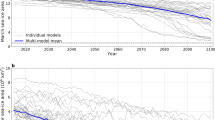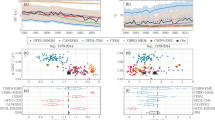Abstract
Dramatic changes in the sea ice characteristics in the Barents Sea have potential consequences for the weather and climate systems of mid-latitude continents, Arctic ecosystems, and fisheries, as well as Arctic maritime navigation. Simulations and projections of winter sea ice in the Barents Sea based on the latest 41 climate models from the Coupled Model Intercomparison Project Phase 6 (CMIP6) are investigated in this study. Results show that most CMIP6 models overestimate winter sea ice in the Barents Sea and underestimate its decreasing trend. The discrepancy is mainly attributed to the simulation bias towards an overly weak ocean heat transport through the Barents Sea Opening and the underestimation of its increasing trend. The methods of observation-based model selection and emergent constraint were used to project future winter sea ice changes in the Barents Sea. Projections indicate that sea ice in the Barents Sea will continue to decline in a warming climate and that a winter ice-free Barents Sea will occur for the first time during 2042–2089 under the Shared Socioeconomic Pathway 585 (SSP5-8.5). Even in the observation-based selected models, the sensitivity of winter sea ice in the Barents Sea to global warming is weaker than observed, indicating that a winter ice-free Barents Sea might occur earlier than projected by the CMIP6 simulations.
摘要
巴伦支海海冰的变化对中纬度大陆的天气和气候系统、北极生态系统、渔业以及北极航运等都具有潜在的影响。本文基于第六次国际耦合模式比较计划(CMIP6)的41个气候模式对巴伦支海冬季海冰的模拟和预估进行了研究。研究结果显示,大多数CMIP6气候模式存在高估巴伦支海冬季海冰覆盖范围和低估海冰覆盖范围下降趋势的共性偏差。这种共性偏差主要与CMIP6气候模式对经过巴伦支海的海洋极向热输送模拟偏弱及低估海洋极向热输送的增加趋势有关。为了减少CMIP6气候模式对巴伦支海海冰预估的不确定性,本文采用模式优选与涌现约束的方法对巴伦支海未来冬季海冰进行了预估。预估的结果表明,气候变暖背景下,巴伦支海冬季海冰将持续减少,在SSP5-8.5排放情景下,巴伦支海将在2042–2089年间首次出现冬季无冰现象。但是,即使根据观测海冰覆盖范围优选的CMIP6气候模式仍低估了巴伦支海冬季海冰对全球变暖的敏感性,这也表明巴伦支海未来首次出现冬季无冰的时间可能比CMIP6气候模式预估的更早。
Similar content being viewed by others
References
Årthun, M., T. Eldevik, L. H. Smedsrud, Ø. Skagseth, and R. B. Ingvaldsen, 2012: Quantifying the influence of Atlantic Heat on Barents Sea ice variability and retreat. J. Climate, 25, 4736–4743, https://doi.org/10.1175/jcli-d-11-00466.1.
Arzel, O., T. Fichefet, and H. Goosse, 2006: Sea ice evolution over the 20th and 21st centuries as simulated by current AOGCMs. Ocean Modelling, 12, 401–415, https://doi.org/10.1016/j.ocemod.2005.08.002.
Behrens, L. K., T. Martin, V. A. Semenov, and M. Latif, 2012: The Arctic Sea ice in the CMIP3 climate model ensemble–variability and anthropogenic change. The Cryosphere, 6, 5317–5344, https://doi.org/10.5194/tcd-6-5317-2012.
Blackport, R., and J. A. Screen, 2020: Weakened evidence for mid-latitude impacts of Arctic warming. Nature Climate Change, 10(12), 1065–1066, https://doi.org/10.1038/s41558-020-00954-y.
Cavalieri, D. J., C. L. Parkinson, P. Gloersen, and H. J. Zwally, 1996: Sea ice concentrations from nimbus-7 SMMR and DMSP SSM/I-SSMIS passive microwave data, version 1. National Snow and Ice Data Center, Boulder, Colorado, USA, https://doi.org/10.5067/8GQ8LZQVL0VL.
Dalpadado, P., and Coauthors, 2014: Productivity in the Barents Sea—Response to recent climate variability. PLoS One, 9, e95273, https://doi.org/10.1371/journal.pone.0095273.
de la Vega, C., and Coauthors, 2022: Multi-decadal environmental change in the Barents Sea recorded by seal teeth. Global Change Biology, 28, 3054–3065, https://doi.org/10.1111/gcb.16138.
Docquier, D., and Coauthors, 2019: Impact of model resolution on Arctic sea ice and North Atlantic Ocean heat transport. Climate Dyn., 53, 4989–5017, https://doi.org/10.1007/s00382-019-04840-y.
Docquier, D., R. Fuentes-Franco, K. Wyser, and T. Koenigk, 2021: A review of interactions between ocean heat transport and Arctic Sea Ice. Environmental Research Letters, 16, 123002, https://doi.org/10.1088/1748-9326/ac30be.
Haarsma, R. J., and Coauthors, 2016: High resolution model intercomparison project (HighResMIP v1.0) for CMIP6. Geoscientific Model Development, 9(11), 4185–4208, https://doi.org/10.5194/gmd-9-4185-2016.
Hansen, J., R. Ruedy, M. Sato, and K. Lo, 2010: Global surface temperature change. Rev. Geophys., 48, RG4004, https://doi.org/10.1029/2010rg000345.
Hop, H., and H. Gjøsæter, 2013: Polar cod (Boreogadus saida) and capelin (Mallotus villosus) as key species in marine food webs of the Arctic and the Barents Sea. Marine Biology Research, 9, 878–894, https://doi.org/10.1080/17451000.2013.775458.
IPCC, 2019: Summary for policymakers. IPCC Special Report on the Ocean and Cryosphere in A Changing Climate, H.-O. Pörtner et al., Eds., Cambridge University Press.
Kay, J. E., M. M. Holland, and A. Jahn, 2011: Inter-annual to multi-decadal Arctic sea ice extent trends in a warming world. Geophys. Res. Lett., 38, L15708, https://doi.org/10.1029/2011gl048008.
Koenigk, T., and R. Fuentes-Franco, 2019: Towards normal Siberian winter temperatures. International Journal of Climatology, 39(11), 4567–4574, https://doi.org/10.1002/joc.6099.
Kwok, R., 2018: Arctic sea ice thickness, volume, and multiyear ice coverage: Losses and coupled variability (1958–2018). Environmental Research Letters, 13, 105005, https://doi.org/10.1088/1748-9326/aae3ec.
Lenssen, N. J. L., G. A. Schmidt, J. E. Hansen, M. J. Menne, A. Persin, R. Ruedy, and D. Zyss, 2019: Improvements in the GISTEMP uncertainty model. J. Geophys. Res., 124, 6307–6326, https://doi.org/10.1029/2018jd029522.
Li, D. W., R. Zhang, and T. R. Knutson, 2017: On the discrepancy between observed and CMIP5 multi-model simulated Barents Sea winter sea ice decline. Nature Communications, 8, 14991, https://doi.org/10.1038/ncomms14991.
Lind, S., R. B. Ingvaldsen, and T. Furevik, 2018: Arctic warming hotspot in the northern Barents Sea linked to declining sea-ice import. Nature Climate Change, 8, 634–639, https://doi.org/10.1038/s41558-018-0205-y.
Lindsay, R., and A. Schweiger, 2015: Arctic sea ice thickness loss determined using subsurface, aircraft, and satellite observations. The Cryosphere, 9, 269–283, https://doi.org/10.5194/tc-9-269-2015.
Liptak, J., and C. Strong, 2014: The winter atmospheric response to sea ice anomalies in the Barents Sea. J. Climate, 27, 914–924, https://doi.org/10.1175/jcli-d-13-00186.1.
Liu, J. P., M. R. Song, R. M. Horton, and Y. Y. Hu, 2013: Reducing spread in climate model projections of a September ice-free Arctic. Proceedings of the National Academy of Sciences of the United States of America, 110(31), 12571–12576, https://doi.org/10.1073/pnas.1219716110.
Long, M. Y., L. J. Zhang, S. Y. Hu, and S. M. Qian, 2021: Multi-aspect assessment of CMIP6 models for Arctic Sea Ice Simulation. J. Climate, 32, 1515–1529, https://doi.org/10.1175/jcli-d-20-0522.1.
Luo, D. H., X. D. Chen, A. G. Dai, and I. Simmonds, 2018: Changes in atmospheric blocking circulations linked with Winter Arctic warming: A new perspective. J. Climate, 31, 7661–7678, https://doi.org/10.1175/jcli-d-18-0040.1.
Meier, W., F. Fetterer, M. Savoie, S. Mallory, R. Duerr, and J. Stroeve, 2013: Near-real-time NOAA/NSIDC climate data record of passive microwave sea ice concentration, version 2. National Snow and Ice Data Center, Boulder, Colorado, USA, https://doi.org/10.7265/tgam-yv28.
Mori, M., Y. Kosaka, M. Watanabe, H. Nakamura, and M. Kimoto, 2019: A reconciled estimate of the influence of Arctic Sea-ice loss on recent Eurasian cooling. Nature Climate Change, 9, 123–129, https://doi.org/10.1038/s41558-018-0379-3.
Notz, D., and SIMIP Community, 2020: Arctic sea ice in CMIP6. Geophys. Res. Lett., 47, e2019GL086749, https://doi.org/10.1029/2019gl086749.
Ogawa, F., and Coauthors, 2018: Evaluating impacts of recent Arctic Sea Ice loss on the Northern Hemisphere winter climate change. Geophys. Res. Lett., 45(7), 3255–3263, https://doi.org/10.1002/2017GL076502.
Onarheim, I. H., and M. Årthun, 2017: Toward an ice-free Barents Sea. Geophys. Res. Lett., 44, 8387–8395, https://doi.org/10.1002/2017gl074304.
Onarheim, I. H., T. Eldevik, M. Årthun, R. B. Ingvaldsen, and L. H. Smedsrud, 2015: Skillful prediction of Barents Sea ice cover. Geophys. Res. Lett., 42, 5364–5371, https://doi.org/10.1002/2015gl064359.
Onarheim, I. H., T. Eldevik, L. H. Smedsrud, and J. C. Stroeve, 2018: Seasonal and regional manifestation of Arctic Sea Ice loss. J. Climate, 31, 4917–4932, https://doi.org/10.1175/jclid-17-0427.1.
O’Neill, B. C., and Coauthors, 2016: The scenario model intercomparison project (scenarioMIP) for CMIP6. Geoscientific Model Development, 9, 3461–3482, https://doi.org/10.5194/gmd-9-3461-2016.
Polyakov, I. V., U. S. Bhatt, J. E. Walsh, E. P. Abrahamsen, A. V. Pnyushkov, and P. F. Wassmann, 2013: Recent oceanic changes in the Arctic in the context of long-term observations. Ecological Applications, 13, 1745–1764, https://doi.org/10.1890/11-0902.1.
Riahi, K., and Coauthors, 2017: The Shared Socioeconomic Pathways and their energy, land use, and greenhouse gas emissions implications: An overview. Global Environmental Change, 42, 153–168, https://doi.org/10.1016/j.gloenvcha.2016.05.009.
Schweiger, A. J., K. R. Wood, and J. L. Zhang, 2019: Arctic sea ice volume variability over 1901–2010: A model-based reconstruction. J. Climate, 31, 4731–4752, https://doi.org/10.1175/jcli-d-19-0008.1.
Shu, Q., Z. Song, and F. Qiao, 2015: Assessment of sea ice simulations in the CMIP5 models. The Cryosphere, 9, 399–409, https://doi.org/10.5194/tc-9-399-2015.
Shu, Q., Q. Wang, M. Årthun, S. Z. Wang, Z. Y. Song, M. Zhang, and F. L. Qiao, 2022: Arctic Ocean Amplification in a warming climate in CMIP6 models. Science Advances, 8, eabn9755, https://doi.org/10.1126/sciadv.abn9755.
Smedsrud, L. H., R. Ingvaldsen, J. E. Ø. Nilsen, and Ø. Skagseth, 2010: Heat in the Barents Sea: Transport, storage, and surface fluxes. Ocean Science, 6, 219–234, https://doi.org/10.5194/os-6-219-2010.
Sorokina, S. A., C. Li, J. J. Wettstein, and N. G. Kvamstø, 2016: Observed atmospheric coupling between Barents Sea ice and the Warm-Arctic Cold-Siberian anomaly pattern. J. Climate, 29, 495–511, https://doi.org/10.1175/jcli-d-15-0046.1.
Stroeve, J., and D. Notz, 2018: Changing state of Arctic Sea ice across all seasons. Environmental Research Letters, 13, 103001, https://doi.org/10.1088/1748-9326/aade56.
Turner, J., T. J. Bracegirdle, T. Phillips, G. J. Marshall, and J. S. Hosking, 2013: An initial assessment of Antarctic sea ice extent in the CMIP5 models. J. Climate, 26, 1473–1484, https://doi.org/10.1175/jcli-d-12-00068.1.
Wang, Q., and Coauthors, 2020: Intensification of the Atlantic water supply to the Arctic Ocean through Fram Strait induced by Arctic Sea Ice decline. Geophys. Res. Lett., 47, e2019GL086682, https://doi.org/10.1029/2019gl086682.
Yashayaev, I., and D. Seidov, 2015: The role of the Atlantic Water in multidecadal ocean variability in the Nordic and Barents Seas. Progress in Oceanography, 132, 68–127, https://doi.org/10.1016/j.pocean.2014.11.009.
Zappa, G., P. Ceppi, and T. G. Shepherd, 2021: Eurasian cooling in response to Arctic sea-ice loss is not proved by maximum covariance analysis. Nature Climate Change, 11(2), 106–108, https://doi.org/10.1038/s41558-020-00982-8.
Acknowledgements
This work was supported by the Chinese Natural Science Foundation (Grant No. 41941012), the Basic Scienti fic Fund for National Public Research Institute of China (ShuXingbei Young Talent Program) under contract No. 2019S06, Shandong Provincial Natural Science Foundation (ZR2022JQ17), and the Taishan Scholars Program (No. tsqn202211264). The CMIP6 data were downloaded from https://esgf-node.llnl.gov/search/cmip6/. The satellite-observed SIC dataset are from NSIDC (http://nsidc.org/data/seaice/). The GISS SAT was provided by https://data.giss.nasa.gov/gistemp/graphs_v4/#. We would like to thank the above data providers.
Author information
Authors and Affiliations
Corresponding author
Additional information
Article Highlights
• Most CMIP6 climate models overestimate winter sea ice in the Barents Sea and underestimate its decreasing trend.
• Discrepancies in modeled sea ice are mainly caused by an overly weak simulated ocean heat transport and the underestimation of its increasing trend.
• It is projected that a winter ice-free Barents Sea will occur for the first time during 2042–2089 under the SSP5-8.5 scenario.
This paper is a contribution to the special issue on Changing Arctic Climate and Low/Mid-latitudes Connections.
Rights and permissions
About this article
Cite this article
Pan, R., Shu, Q., Song, Z. et al. Simulations and Projections of Winter Sea Ice in the Barents Sea by CMIP6 Climate Models. Adv. Atmos. Sci. 40, 2318–2330 (2023). https://doi.org/10.1007/s00376-023-2235-2
Received:
Revised:
Accepted:
Published:
Issue Date:
DOI: https://doi.org/10.1007/s00376-023-2235-2




